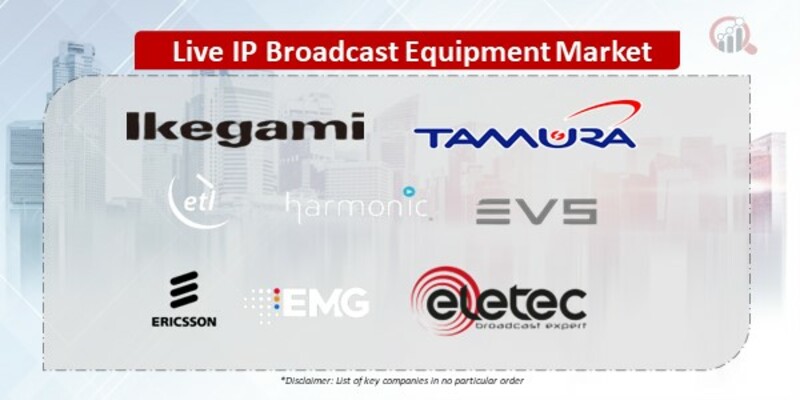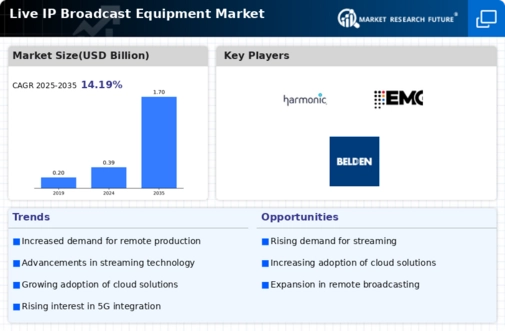Top Industry Leaders in the Live IP Broadcast Equipment Market

The Competitive Landscape of the Live IP Broadcast Equipment Market
The Live IP Broadcast Equipment Market is experiencing a renaissance, driven by the relentless adoption of Internet Protocol (IP) technology in the media and entertainment industry. This shift towards IP-based workflows promises greater flexibility, cost-efficiency, and scalability, opening up a dynamic and lucrative landscape for established players and nimble startups alike. Understanding the competitive landscape, key factors influencing market share, and emerging trends is crucial for navigating this burgeoning space.
Some of the Live IP Broadcast Equipment companies listed below:
- Ikegami Tsushinki Co. Ltd
- TAMURA Corporation
- ETL Systems Ltd
- Harmonic Inc.
- EVS Broadcast Equipment SA
- Telefonaktiebolaget LM Ericsson
- Euro Media Group
- Eletec Broadcast Telecom SARL
- Sony Corporation
- Belden Inc.
- Evertz Microsystems Ltd
- Cisco Systems Inc.
Strategies Adopted by Leaders:
- Embracing Open Standards and Interoperability: Adherence to open standards like SMPTE ST 2110 ensures seamless integration with existing workflows and equipment from different vendors, fostering market adoption.
- Prioritizing Security and Reliability: Live broadcasting demands absolute reliability and robust security measures to prevent data breaches or signal disruptions. Offering end-to-end solutions with strong encryption and redundancy features builds trust and market share.
- Cloud-Based Solutions and Remote Production: Leveraging cloud technology for storage, processing, and delivery offers cost-efficiency and flexibility, particularly for smaller broadcasters. Developing reliable remote production workflows also caters to the trend of decentralized production teams.
- Partnerships and Ecosystem Building: Collaborating with other players in the broadcast ecosystem, such as content delivery networks (CDNs) or telecommunications providers, can expand reach and offer comprehensive solutions.
- Investing in R&D and Innovation: Continuously innovating with new features, advanced compression algorithms, and AI-powered tools for automation or analytics attracts technology-driven broadcasters and solidifies market leadership.
Factors for Market Share Analysis:
- Product Portfolio and Technological Breadth: The range and sophistication of equipment offered by a vendor, encompassing cameras, encoders, routers, and software solutions, significantly impact their market presence. Offering cutting-edge features like HDR (High Dynamic Range) support, low latency streaming, and cloud-based production tools are key differentiators.
- Target Market Focus: Catering to specific segments within the broadcast industry, such as sports production, newsgathering, or religious institutions, requires tailored solutions and partnerships. Addressing the unique needs of each segment can solidify market share within that niche.
- Geographical Penetration and Distribution Channels: Global reach and established distribution networks through broadcast equipment partners or reseller agreements play a vital role in market capture. Expanding into emerging regions with high growth potential can be a strategic driver.
- Brand Reputation and Trust: In this tech-heavy space, a strong brand built on reliability, technical expertise, and innovation inspires confidence among broadcasters. Established players like Cisco and Grass Valley often have an edge in this regard.
- Pricing Strategy and Value Proposition: Striking the right balance between affordability and feature depth is essential. Offering flexible pricing models like subscriptions or service-based contracts can broaden appeal and increase market share.
New and Emerging Companies:
- Agile Startups with Niche Specializations: Companies like AJA Video Systems and TAG Video Systems focus on specific segments like video capture or software-defined workflows, offering niche solutions tailored to address specific pain points.
- Software-Centric Solutions: Companies like Haivision and Magewell focus on software-based encoders and streaming solutions, offering cost-effective alternatives to traditional hardware-based equipment and appealing to budget-conscious broadcasters.
- Cloud-Native Production Providers: Cloud-based platforms like Enco and Grabyo offer comprehensive production, editing, and delivery solutions entirely in the cloud, particularly attractive for smaller production teams or live streaming applications.
Latest Company Updates:
On Aug. 22, 2023, Videon, a video encoding provider, announced a partnership with a developer of live video over IP, Zixi, to distribute and manage video over IP. Videon's LiveEdge is a powerful container-based edge computing ecosystem with sub-second glass-to-glass latency. Integrating Zixi's tech platform into Videon's LiveEdge allows users to manage large-scale configurations & orchestrate, analyze, monitor, and report on live video streams and devices.
On Apr. 07, 2023, Panasonic Connect announced the development of a new IP-compatible compact live switcher, the AV-HSW10, for easy, high-quality video streaming. Panasonic's predecessor AW-HS50 live switcher can be used in university lectures, corporate webinars, and other diverse live events. The new model features a compact body with 10-bit processing and helps achieve higher operability, reliability, and advanced IP compatibility, making it the ideal choice for contemporary live video production.
On Apr. 16, 2023, At NAB 2023, Blackmagic Design announced a new rack mount converter, the Blackmagic 2110 IP Converter 3x3G. The new converter features 10G Ethernet and converts 3G-SDI devices to 2110 IP broadcast systems. Blackmagic 2110 IP Converter 3x3G can support up to 3 separate 3G-SDI video channels at the same time. Moreover, it includes an elegant front panel with a color LCD for monitoring, menus and diagnostics.
On Apr. 21, 2023, Chyron launched an end-to-end, cloud-native live video production platform, Chyron LIVE, with high-end switching & graphics, clips player, replay, telestration, and asset management capabilities. Moreover, Chyron LIVE makes it easy for operators to deliver a live production on the fly, using live camera feeds through various transport protocols.








